The e-learning market emerged rapidly during a time of global distress and has continued to grow since then.
You may be surprised to learn that, even after the pandemic, students continue to show a high interest in pursuing their courses online, solidifying their stance on e-learning.
The e-learning market was valued at $399.3 billion in 2022, and it is projected to reach $1 trillion by 2032 with a CAGR of 14%. This multi-fold growth indicates the potential of the market, and this is just the tip of the iceberg.

In this post, let us take a look at some of the e-learning stats that will help you understand the market better. More importantly, it will give you an idea of how suitable it is to enter the market by building an e-learning platform or app of your own.
Hence, if you plan to enter the market, this blog is certainly a must-read for you!
Without further ado, let’s get started!
E-Learning Stats that Matter! 15+ Stats to Keep in Mind
Before we jump into the intricacies, let’s take a look at some of the core stats that will help you get a glimpse of the market and the user perspective about using the application. These stats are a mix of multiple fields, combining the growth of e-learning, corporate learning, student preferences, and more.
- The e-learning market has seen a 900% growth since 2000, which indicates the rise in interest among users.
- Revenue from the online learning industry is expected to reach $279.30 billion by 2029.
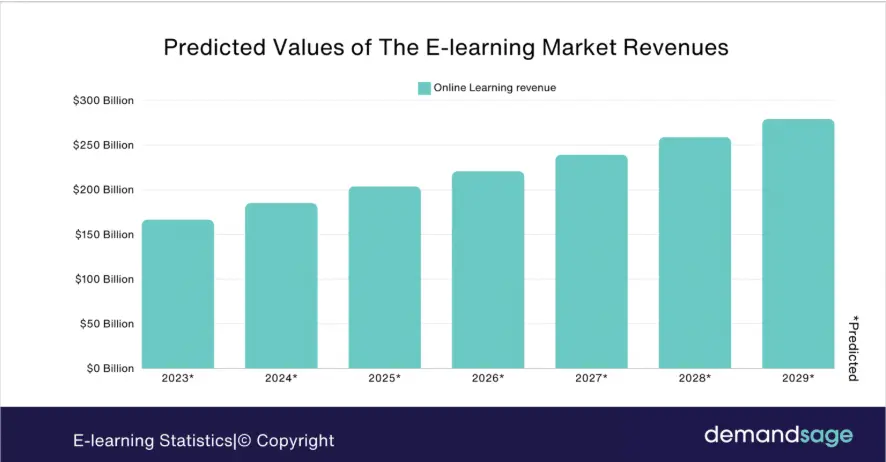
- A whopping 73% of U.S. students want to continue taking online classes even after the pandemic.
- Companies are embracing digital learning! 90% of them offer some form of online training for their employees.
- Employees are all for learning on the job! A strong 68% of them say they prefer to gain new skills and knowledge at work.
- As a result of all this, the increasing popularity of online learning platforms is undeniable. Apps like Udemy, Coursera, and other top educational apps are seeing a surprising increase in their registrations.
- Even Coursera alone has seen a 438% increase in the number of registered learners in just five years.
- It is evident from corporate e-learning statistics that a staggering 90% of companies are now offering some form of e-learning to their employees.
- In addition, IBM reported that its managers learned 5 times more content through eLearning compared to traditional training methods.
- 85% of teachers leverage the interactive nature of e-learning to improve student engagement.
- With the increase in development of educational apps, experts expect this market to keep growing at a rate of 8.9% annually until 2030.
- Students tend to retain 25-60% of what they learn through online learning and digital platforms, making it increasingly viable for them.
- When it comes to corporate e-learning, employees often report that e-learning is more convenient and requires fewer resources (time and money) than traditional training and learning solutions.
- E-learning solutions have certainly made conceptual learning more effective, considering that online coaching and courses see a completion rate of 70%, which means more and more users finish the course they start online.
- Employment engagement has certainly increased with the implementation of LMS in the training and education of new employees.
- Companies using online learning programs have observed a growth in revenue per employee of 42% making it a great addition to the training process.
- The number of e-learning users seems to be increasing rapidly and can touch a whopping 57 million users by 2027.
- In the United States alone, 63% of students use an e-learning platform every day, which shows the impact of e-learning platforms.
With all these stats, you might have a solid idea of how e-learning has grown over the past few years and is still on a growing path. Now that you have understood the path on which the market is going, let’s break down these stats and understand the market in more detail.
EdTech Market Segmentation
EdTech, short for Educational Technology, is a vast and ever-evolving market.
To get to know it better, let’s segment it based on various factors. Here’s a breakdown of some key EdTech market segmentation approaches:
► By Target Audience
Despite different age groups, everyone is connecting to educational apps to gain access to educational material. Here are some eLearning statistics that paint a detailed picture of the same.
-
Preschool
For the development of a child, parents often take the help of different preschool apps such as ABCmouse.com, Khan Academy Kids, and Quick Math Jr. Here are some leading learning apps for children. Take a look at the image below to learn about them:
Looks like the market is in favour of ABCmouse and shows that it is getting traction all over the world, making it one of the most popular apps among children, with 2.5 million downloads on Android and iOS.
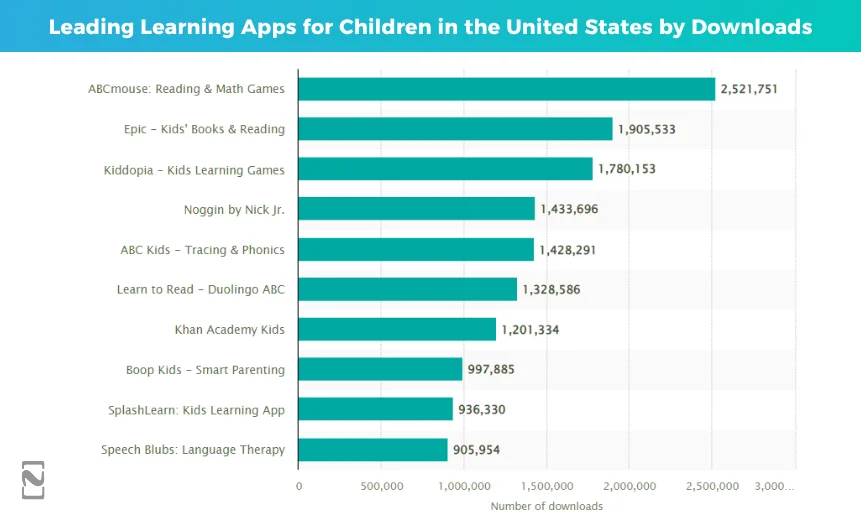
Meanwhile, Kiddopia secured the second spot with 1.45 million downloads. This trend of high download numbers is likely to continue its upward trend and will see more growth in the 2024-2030 period.
-
K-12
Children are engaged with educational apps, and that’s clear from these insightful market stats. The K-12 online education market will see an explosion, as the size is expected to surge from $1.274 billion in 2022 to a staggering $6.1 billion by 2031.
Through this, it’s quite visible that the CAGR will see an increase of 19%, showing a shift towards online learning in K-12 education. And that’s also visible in the picture.
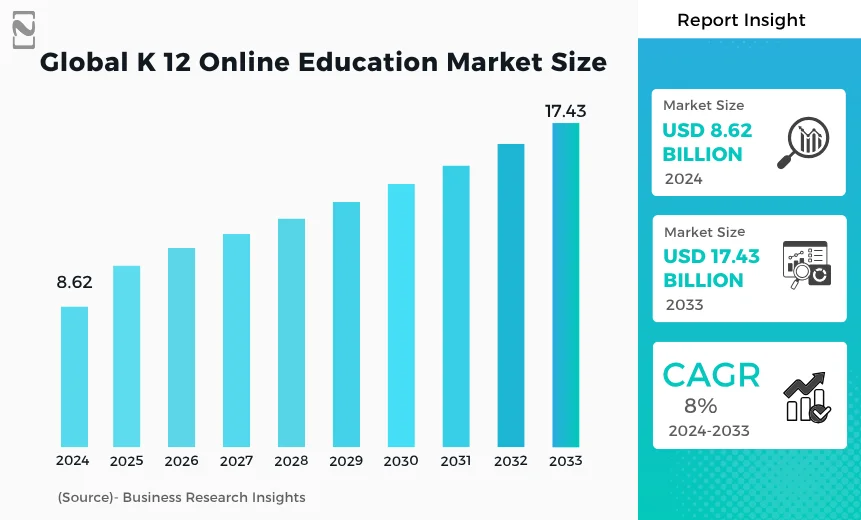
► Higher Education
Talking about higher education is what lays the foundation for our brighter future.
We go to college and get a better education to shape our careers. But not everyone can access such facilities. And, the result is quite visible: over 10 million college students embraced online learning in the fall of 2022.
A significant portion (slightly less than half) opted for a fully online education experience. Consequently, the online university education market is expected to reach $120.70 billion by 2024.

-
Corporate
In today’s rapidly evolving job market, continuous learning is crucial.
To stay ahead of the curve, many professionals are turning to educational apps like edX to upskill and shape their careers.
In 2023, the global corporate eLearning industry reached an impressive $22.15 billion, and research predicts even sharper growth in the coming year. With a CAGR of 10.9%, the market is expected to surpass $46 billion by 2030.

► By Subject Area
Let’s dive into the subjects that consistently captivate users and spark a desire to learn more through the app.
-
Maths
More than 100 million students globally fail math every year. That’s huge, right? This is why students take the help of math apps like Photomath, Khan Academy Kids, and more.
The global mathematical software market is expected to see huge growth; experts are predicting an increase in Compound Annual Growth Rate (CAGR) exceeding 8.5% between 2018 and 2025.
This means the market value of these apps will be $8.17 billion by 2025.

-
STEM
STEM includes Science, Technology, Engineering, and Maths. These apps provide access to a lot of content on different subjects; this is why Science Apps are so famous.
The K-12 STEM education market is experiencing a boom! The market was valued at $37.84 billion in 2021; it’s expected to witness a substantial surge in growth at a CAGR of 14.6% from 2022 to 2030.
-
Language Learning
Another key focus is on language learning. Language learning apps such as Babbel are so popular that there aren’t only learners and investors in Babbel-like app development.
Nonetheless, learning an extra language has its own advantages. With that, the language learning app market is on a full upward trend, seeing a surge from a value of $20.34 billion in 2023 to $89.53 billion by 2031.
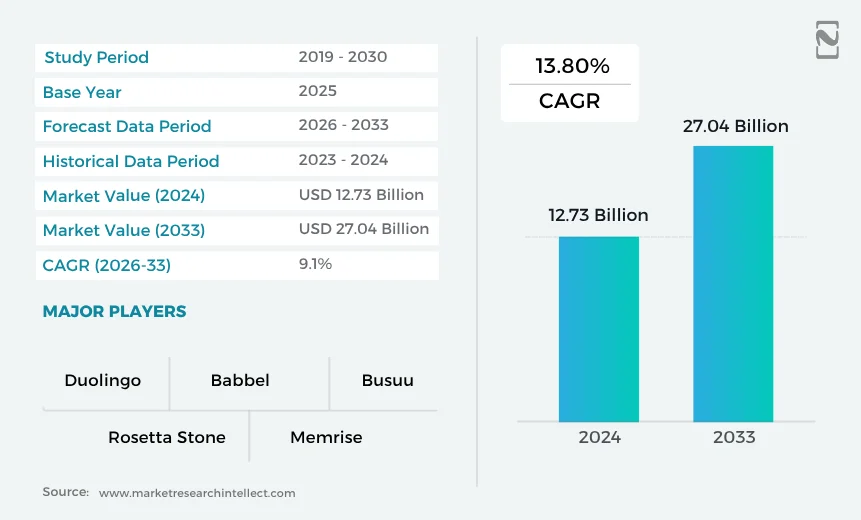
The market is expected to witness a 17.9% CAGR during the given period.
► By Learning Style
It is universal that not all students learn the same way. Let’s explore different learning styles and how many people approach these styles, which helps them to understand different concepts.
-
Visual Learning Style
Visual learners are all about visuals. Many students learn most effectively by seeing information presented through images, diagrams, and other visual aids.
This allows them to effectively process and retain knowledge. An estimated 65% of the population learns best through visual learning and demonstrations.
-
Auditory Learning Style
Auditory learning style is a way of processing information through listening. Meaning, these learners absorb information best when it’s presented through spoken words.
Lectures, group discussions, podcasts, and audiobooks become their learning havens. The auditory learning style is often overlooked, with just 20%-30% of schools actively integrating it into their curriculum.
-
Kinesthetic Learning Style
Kinesthetic learners, also known as tactile learners, are the ultimate “hands-on’’ bunch. They thrive in environments that allow them to learn through
ugh movement, interaction & physical experience.
An estimated 25%-30% of students identify as kinesthetic learners. This group thrives in hands-on educational environments, where they can learn by doing & engaging with the material.
► eLearning App Revenue Model
Edtech market analysis shows that it’s undergoing a revolution, and the revenue model is at the heart of it.
Let’s delve into the various education app business models, revealing how learning is delivered and valued in the modern world.
-
Freemium
In-app purchases are king in the education market, with revenue of $3.54 billion in 2022. The market has shown a tremendous increase since then and is expected to grow even more between 2025-2030.
This shows a growing trend of learners seeking additional features and resources within educational apps.
-
Paid Subscription
In the education market, in-app purchases govern supreme, with projected revenue of $ 3.54 billion in 2022, dwarfing the $0.18 billion expected from paid apps.
This suggests that subscription-based apps are valued by learners. Also, people are taking an interest in on-demand learning, ensuring supplemental resources within existing apps.
-
In-App Purchase
The education market is witnessing a shift towards in-app purchases! While paid apps are expected to reach a staggering $3.54 billion.
Country-Wise Insights on EdTech
Here are some eLearning regional penetration statistics that will surely blow your mind. Let’s get right into it:
-
US Educational Market Statistics
The United States is a powerhouse in the global EdTech Market, leading the charge in educational innovation. As per the educational market statistics, North America dominates the market with a projected CAGR of 10.3% by 2030.
With significant investments in EdTech and the increasing adoption of digital signage for universities and corporate environments, the US is setting the stage for rapid growth in educational technology.
This dominance can likely be attributed to significant investments in the Edtech Sector by Venture Capitalists.
-
UK Educational Market Statistics
Experts suggest there is huge potential in the UK educational market. As per Edtech Market Statistics, the educational app market in the UK was generating revenue of $315 million.
The figure dominates the $17.5 million earned by the Irish educational app market, and the market is expected to heat up in the coming years.
Analysts predict a CAGR of 11.88% between 2022 and 2027. This translates to $591.60 million by 2027.
-
Asia-Pacific: The Rising Star Educational Market Statistics
The Asia-Pacific Region is no longer just an emerging player, but surging beyond its emerging market status and becoming a major global player!
The reason is, with the widespread adoption of smartphones and internet access, a vast population is now connected and ready to learn online. And, it is said that the Asia-Pacific region is experiencing explosive growth, with a projected CAGR of 17.1% by 2030.
-
Europe: A Hub For Innovation
Europe is an upbringing ground for cutting-edge educational technology.
With a focus on research and development, European companies are constantly pushing the boundaries of what’s possible in Edtech.
Analysts predict continued growth at a CAGR of 14.2% by 2030.
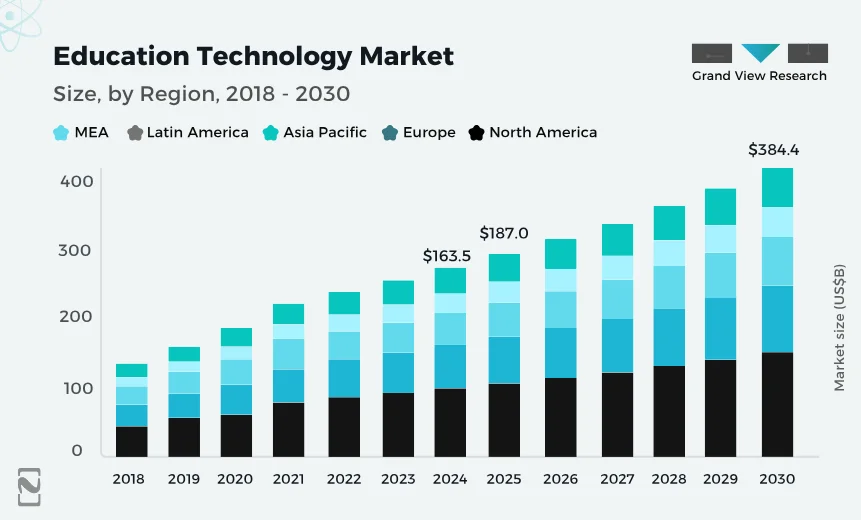
-
Middle East EdTech Market Statistics
While North America, Asia-Pacific, and Europe dominate the EdTech Conversation, the Middle East is not behind but is emerging as a region with immense potential.
The educational market is projected to grow at a CAGR of 9.14% from 2024 to 2030.
With continued government support, increasing internet penetration, and a growing population, more and more investors are coming forward to turn their educational app idea into a solution to cater to all these people.
Well, with that said, there’s still a lot to uncover.
With that, we believe you now have an idea of the growing e-learning statistics in the market. Now, we will take a look at the impact on Learning.
Hype of Mobile Learning
“The future of learning in your pocket.” Sounds amazing, right?
With over 2 billion people using mobile devices for everything from social media to work, it’s clear the craze for mobile apps is here to stay.
With that, let’s check out how mobile learning is shaping the future of education.
Mobile learning will significantly drive the e-learning market, pushing its CAGR to 17.9% and taking the market to $77.4 billion by 2025.
This surge isn’t surprising, but organisations are taking note, and as a result, a whopping 67% have already incorporated mobile learning into their training programs, reaping the benefits of a 73% boost in productivity.
But the question is, what makes mobile learning so effective? Well, in the words of learners, 70% of them feel confident while learning on their phones as compared to their desktops.
It also shows real-world benefits: 43% of mobile learners experience increased productivity compared to non-mobile users. With this, it’s not wrong to say that mobile learning is the king.
89% of smartphone users download an app, among which a full 50% use those apps for learning. As a result, mobile-only users (27%) outnumber people who access from a desktop, which is around 14%.
Even millennials are embracing mobile learning. A staggering 71% report a stronger connection with mobile learning compared to traditional desktop-based methods.
Impact of Educational Apps on Learning Outcomes
If you are still wondering whether or not an effective eLearning environment is crucial for students, we are here to share some compelling education statistics that shed light on the impact of technology on learning.
- A majority, 86% of teachers, believe EdTech is essential for effective learning.
- Showing high enthusiasm, 92% of teachers would like to leverage EdTech even further in their classrooms.
- A staggering 89% of teachers utilise EdTech, demonstrating its widespread adoption in K-12 education.
- Technology keeps learning exciting! 76% of students report that EdTech makes the process more engaging.
- 90% of teachers credit EdTech with improving their ability to assess student learning, leading to better outcomes.
- Digital Learning resources are cost-saving, leading to 33-35% less than traditional textbooks.
- Research shows that students in online learning environments often outperform those in traditional face-to-face settings.
- Technology empowers teachers to differentiate instruction, with 65% of elementary teachers utilising it to customise learning for each student.
Education App User Demographics
Now, let’s talk about the user demographic in this industry, which is yet another surprising & amazing section to look at to understand the market better.
EdTech is attracting learners of all ages, but some groups stand out. Young adults take the lead, so they make up the majority.
- 25-34 make up the largest user base of 28.39%.
- Close behind are 18-24-year-olds, representing 23.56% of users.
The trend continues with steady participation from other age groups:
- 35-44 (15.55%),
- 45-54 (15.32%),
- 55-64 (11.04%),
- And even those over 65 make up 6.13%.
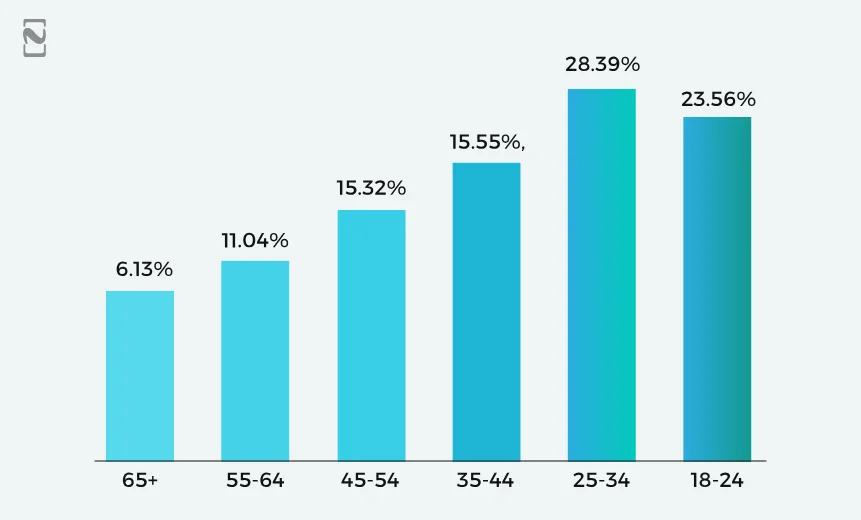
Interestingly, the data suggests a gender gap in EdTech users. Males currently hold a majority share at 56.35% compared to females, who are 43.65%. This shows the opportunity for EdTech platforms to cater to and attract more female learners.
The cost to develop an educational app also plays a crucial role in implementing e-learning solutions for different demographics, as for some, it is easy to access, and for some, the resources are unavailable.
With a strong base across generations, EdTech paints a clear picture of growth for better expansion.
How Nimble AppGenie Can Help You Leverage the Growing Education Market?
Seeing these E-learning stats, it is quite evident that the education app market is flourishing. This market, fueled by the positive impact of technology on learning, attracts significant investor interest.
If you are also someone who wants to be a part of this market, you can take the help of Nimble AppGenie, a top education app development company, to develop an education app that delivers an amazing experience.
We’ll integrate the best features of educational apps, cutting-edge trends, and powerful tools to make your app stand out in the booming education market.
Don’t Let Your education app idea stay an Idea! Contact Us Now.
Conclusion
The education market is experiencing a digital revolution, driven by the surging popularity of EdTech solutions.
This blog post explores the booming EdTech market, highlighting impressive growth statistics across different regions and educational app categories.
We saw how technology is impacting learning positively, with benefits for both students and teachers.
All these stats state that the e-learning market is here to stay, and if you plan to enter the market, the time is certainly ripe. Reach out to an app development company and take your first step towards a thriving business.
FAQs
The EdTech market is booming, with a projected value of $549.6 billion by 2033, compared to $146 billion in 2023. This explosive growth, fueled by the pandemic’s impact and the convenience of online learning, suggests a strong future for EdTech.
Multiple factors contribute to the rise of educational apps. The increased demand for flexible and accessible learning, fueled by a rise in mobile device usage, is a major driver. Additionally, EdTech offers personalised learning experiences that cater to individual needs and learning styles, attracting students and investors alike.
The EdTech market boasts a diverse range of apps. From language learning giants like Duolingo to comprehensive platforms like Khan Academy, the options cater to various needs.
Photomath solves math problems, Google Classroom streamlines classroom management, and Kahoot transforms learning into a game. Quizlet offers flashcards for memorisation, while Udemy provides online courses, and Sololearn teaches coding.
Studies reveal the positive impacts of technology on learning. EdTech tools can make the process more engaging and interactive, leading to better information retention and improved learning outcomes.
Technology also personalises learning experiences and empowers teachers with better assessment tools. Additionally, digital resources can be more cost-effective than traditional textbooks.
If you have a vision for an innovative education app, consider partnering with an experienced education app development company. They can help refine your idea, develop a user-friendly interface, integrate the latest EdTech trends, and build a scalable app that caters to the needs of learners and educators alike.
By collaborating with the right team, you can turn your vision into reality and become part of the exciting EdTech revolution.

Niketan Sharma, CTO, Nimble AppGenie, is a tech enthusiast with more than a decade of experience in delivering high-value solutions that allow a brand to penetrate the market easily. With a strong hold on mobile app development, he is actively working to help businesses identify the potential of digital transformation by sharing insightful statistics, guides & blogs.
Table of Contents





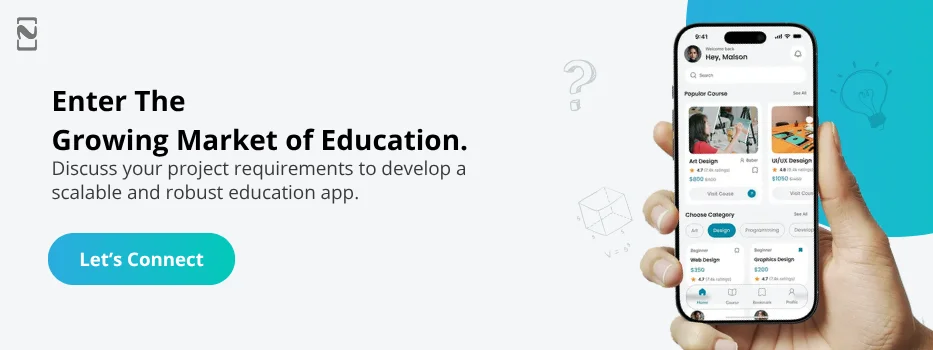
No Comments
Comments are closed.